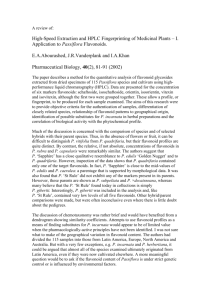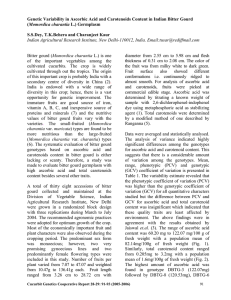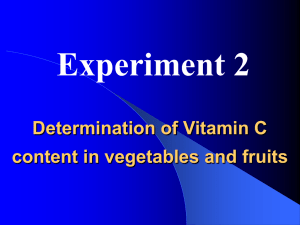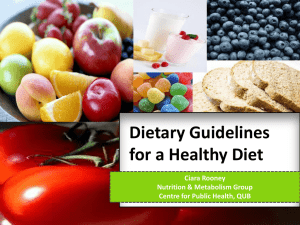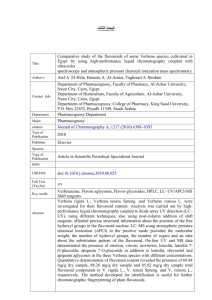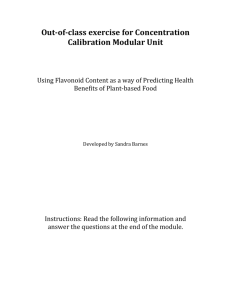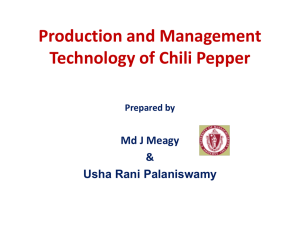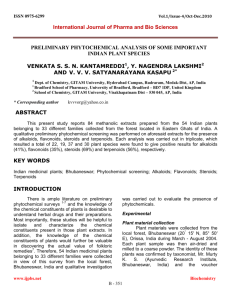Ascorbic Acid
advertisement
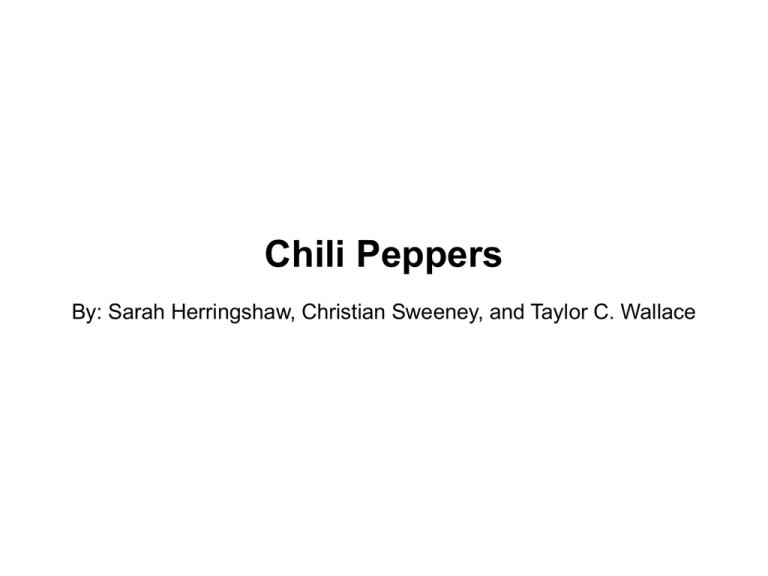
Chili Peppers By: Sarah Herringshaw, Christian Sweeney, and Taylor C. Wallace Capsicum Pepper Fruit Contains Many Phytochemicals at Varying Levels • Phytochemicals in Capsicum Fruit – Ascorbic Acid – Carotenoids – Flavonoids – Capsaicinoids • Factors effecting Phytochemical levels – Genetic Variation – Environment – Plant Maturity Genetic Variation Effects Phytochemical Levels in Pepper Fruit mg/100g Fresh Weight % RDA (60mg/100g) Species Type Cultivar Maturity frutescens Tabasco McIlhenny Green 15 25 annuum Serrano Hidalgo Red 263 438 Howards, Luke R. "Antioxidant Vitamin and Phytochemical Content of Fresh and Processed Pepper Fruit." Handbook of Nutraceuticals and Functional Foods. CRC P LLC, 2001. 209-233. • Carotenoids in part responsible for pepper color – Red terminal maturity (McIlhenney Tabasco) increases provitamin A activity • Carotonoid levels similar within breeding lines Genetic Control (Howard, 2001) Genetic Variation (cont’d) Flavonoid Content of Fresh Capsicum Fruit Species Type Cultivar Maturity chinense Habanero Red Savina Red annuum Yellow Wax Hungarian Yellow Yellow mg /100g Fresh Weight 1 852 Howard, Luke R. "Antioxidant Vitamin and Phytochemical Content of Fresh and Processed Pepper Fruit." Handbook of Nutraceuticals and Functional Foods. CRC P LLC, 2001. 209-233. • Flavonoid content ranges from 1mg/100g fresh to 852mg/100g fresh – Higher levels of Quercetin than Luteolin – Linked to genetic capacity – If genetic control is understood, it can be controlled – Steps have been made to genetically alter the heat of jalapenos (Howard, 2001) Environment Effects Phytochemical Presence in Pepper Fruit • Why do peppers have phytochemicals? – Grown under stress (high heat, little saline water). – Likely target for oxidative damage. – Antioxidant phytochemicals help defend (Navarro, 2006). • Environment stress increases flavonoid production in pepper plants (Howard, 2001). • Fertilizer increases Ascorbic Acid content. – Phosphorous up to 48kg/ha w/ varying Nitrogen levels. • Peppers of the same cultivar in same field may have wildly different capsaicinoid content. Plant Maturity Effects Phytochemical Levels in Pepper Fruit • Maturity is so important because it is easily controlled Ascorbic Acid Content of Fresh Capsicum Fruit mg/100g Fresh Weight % RDA (60mg/100g) Species Type Cultivar Maturity frutescens Tabasco McIlhenny Green 15 25 frutescens Tabasco McIlhenny Red 75 125 Howards, Luke R. "Antioxidant Vitamin and Phytochemical Content of Fresh and Processed Pepper Fruit." Handbook of Nutraceuticals and Functional Foods. CRC P LLC, 2001. 209-233. • Ascorbic acid content of McIlhenny Tabasco increases from 15mg/100g (25%RDA) to 75mg/100g (125% RDA) – Could be due to an increase in sugar precursors of Asc. Acid (Osuna-Garcia, 1998) – Decrease shown in later stages due to use by plant (Markus, 1999) Plant Maturity (cont’d) • Flavonoid levels decrease with maturity – Due to metabolic conversion (Barz and Hoesel, 1977) • Maximum capsaicinoid content studies – Optimal 28-50 days after flowering – After 50 days decline • Possibly due to increased peroxidase activity in late stages of maturity (Iwai,1979; Contreras-Padilla, 1998) Phytochemicals in Chili Peppers • Ascorbic Acid – L-ascorbic and L-dehydroascorbic acid • Flavonoids – luteolin and quercein • Carotenoids – ketocarotenoids, capsanthin, capsprubim • Capsaicinoids - Capsaicin Ascorbic Acid • Found in the flesh of the pepper fruit • Red tabasco peppers contain 75mg/100 grams or 125% of the RDA Osuna-Garcia, 1998 Ascorbic Acid Absorption • Ascorbate– Na+ dependent – Requires energy • Dehydroascorbic acid – Does not requires energy or Na+ – Enters cell creating dehydroascorbic acid gradient – Once inside it is reduced to ascorbic acid by dehydroascorbic acid reductase Rumsey and Levine, 1998 Flavonoids • Peppers are good sources of both quercin and luteolin • Peppers contain very high levels of luteolin at 44mg/kg Hernandez, 1996 Flavonoid Absorption • Flavonoids are absorbed once the attached sugar molecule is cleaved by bacteria in the colon this usually degrades the ring structure of the flavonoid as well. • The free flavonoid can then be absorbed for use in the body Hollman and Katan, 1997 ; Hernandez, 1996 Carotenoids • Absorption is dependent on fat content of food matrix • Absorbed through the intestine where the lipophilic carotenoids migrate through the lipid bilayers of the cells. Yonekura and Nagao, 2007 Capsaicinoids • Capsaicin is fat soluble and is better absorbed with high fat foods • When used for pain treatment it interacts with nerve endings causing a neurotransmitter relase. • Repeated ingestion eventually deplets the body supply of the substance • This causes the nerves to be non responsive Duttia-Roy, 1999 Bioavailability • Bioavailability among capsaicin and tocopherols vary according to the food matrix and processing conditions (80% in vitro and 10% in vivo). • Carotenoid bioavailability affected by the diet (eg. Fat). • Quercetin affected by sugar and/or acid conjugations • Vitamin C absorption is dependant on the amount of Na+ present. Toxicity • Intake of capsaicin has lead to biochemical changes in the body. • Erosion of human gastric mucosa. • Ulceration of the stomach, esophagus, and duodenum. • Toxicity of Carotenoids, Flavonoids, and Ascorbic Acid is VERY RARE! • However deficiencies in the under-developed world may lead to certain nutrient disorders. • Currently the United States FDA recommends a daily allowance of 60mg/dL of Vitamin C (Ascorbic Acid). Health Benefits • Capsaicin • Treatment of pain and inflammation (interaction with human nerve endings). • Topical treatment for allergies and arthritis. • Urological disorders, headaches, and shingles. • Antioxidant and anti-mutenogenic activity by inducing apoptosis and inhibiting chemical carcinogenesis. • Tocopherols • Effective antioxidants and radical scavenging compounds inhibit oxidation of fatty acids. – Positive effect on eye lens, blood vessels, and nerve tissue. • Decreased progression of some neurological disorders. Health Benefits • Flavonoids and Carotenoids • Powerful antioxidants with the ability to induce apoptosis in cancer cell lines. • Show a protective effect on the oxidation of DNA. • Thus aide in the prevention and suppression of many age and obesity related chronic diseases. • Ascorbic Acid • A primary defense against lipid oxidation. • Increased anti-radical scavenging activity in the lungs. Questions? References available upon request.
